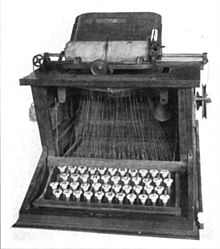Although many modern typewriters have one of several similar designs, their invention was incremental, provided by numerous inventors working independently or in competition with each other over a series of decades. As with the automobile , telephone , and telegraph , a number of people contributed insights and inventions that eventually resulted in ever more commercially successful instruments. In fact, historians have estimated that some form of typewriter was invented 52 times as thinkers tried to come up with a workable design.
In 1714, Henry Mill obtained a patent in Britain for a machine that, from the patent, appears to have been similar to a typewriter. The patent shows that this machine was actually created: "[he] hath by his great study and paines & expence invented and brought to perfection an artificial machine or method for impressing or transcribing of letters, one after another, as in writing, whereby all writing whatsoever may be engrossed in paper or parchment so neat and exact as not to be distinguished from print; that the said machine or method may be of great use in settlements and public records, the impression being deeper and more lasting than any other writing, and not to be erased or counterfeited without manifest discovery."
Italian Pellegrino Turri invented a typewriter in 1808. He also invented carbon paper to provide the ink for his machine. Many early machines, including Turri's, were developed to enable the blind to write.
In 1829, William Austin Burt patented a machine called the "Typographer" which, in common with many other early machines, is listed as the "first typewriter". The Science Museum (London) describes it merely as "the first writing mechanism whose invention was documented," but even that claim may be excessive, since Turri's invention pre-dates it. Even in the hands of its inventor, this machine was slower than handwriting. Burt and his promoter John D. Sheldon never found a buyer for the patent, so the invention was never commercially produced. Because the typographer used a dial, rather than keys, to select each character, it was called an "index typewriter" rather than a "keyboard typewriter." Index typewriters of that era resemble the squeeze-style embosser from the 1970s more than they resemble the modern keyboard typewriter.
By the mid-19th century, the increasing pace of business communication had created a need for mechanization of the writing process. Stenographers and telegraphers could take down information at rates up to 130 words per minute, whereas a writer with a pen was limited to a maximum of 30 words per minute (the 1853 speed record).
From 1829 to 1870, many printing or typing machines were patented by inventors in Europe and America, but none went into commercial production.
Charles Thurber developed multiple patents, of which his first in 1843 was developed as an aid to the blind, such as the 1845 Chirographer. In 1855, the Italian Giuseppe Ravizza created a prototype typewriter called Cembalo scrivano o macchina da scrivere a tasti ("Scribe harpsichord, or machine for writing with keys"). It was an advanced machine that let the user see the writing as it was typed. In 1861, Father Francisco João de Azevedo, a Brazilian priest, made his own typewriter with basic materials and tools, such as wood and knives. In that same year the Brazilian emperor D. Pedro II, presented a gold medal to Father Azevedo for this invention. Many Brazilian people as well as the Brazilian federal government recognize Fr. Azevedo as the real inventor of the typewriter, a claim that has been the subject of some controversy[citation needed]. In 1865, John Pratt, of Centre, Alabama, built a machine called the Pterotype which appeared in an 1867 Scientific American article and inspired other inventors. Between 1864 and 1867 Peter Mitterhofer, a carpenter from South Tyrol (former part of Austria) developed several models and a fully functioning prototype typewriter in 1867.







ليست هناك تعليقات:
إرسال تعليق